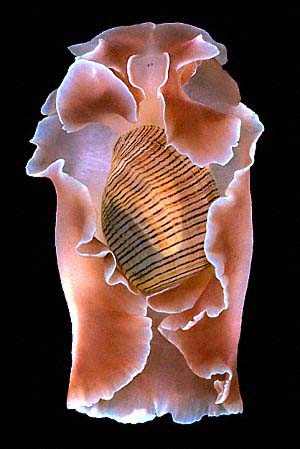
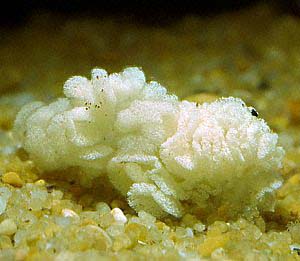
Hydatina physis
(Linnaeus, 1758)
Order: CEPHALASPIDEA
Superfamily: ACTEONOIDEA
Family: Hydatinidae
DISTRIBUTION
Found circum-globally in tropical waters both in the Indo-West Pacific and the Atlantic.
PHOTO
UPPER: Shelly Beach, Manly, Sydney, New South Wales. October 1984. Shell length 45mm. PHOTO: Bill Rudman.
LOWER: Egg mass. Long Reef, Sydney, New South Wales. (Photographer unknown).
RELATED TOPIC
The Hydatinidae are the most modified of a group of cephalaspids which show the gradual diminution in the importance of the shell as a protective organ. The least modified are the acteonids (Pupa, Acteon) with a heavily calcified shell and a small, usually uncoloured animal. In Hydatina and Micromelo the shell has become thin and the animal large and brightly coloured. The protective operculum has disappeared. Species of Hydatina are very specialised worm feeders, eating only cirratulinid polychaete worms.
Reference:
• Rudman, W.B., 1972. The anatomy of the opisthobranch genus Hydatina and the functioning of the mantle cavity and alimentary canal. Zoological Journal of the Linnean Society, 51: 121-139.
Rudman, W.B., 1998 (December 18) Hydatina physis (Linnaeus, 1758). [In] Sea Slug Forum. Australian Museum, Sydney. Available from http://www.seaslugforum.net/find/hydaphys
Related messages
Re: Food for the bubble shell Hydatina physis?
December 16, 2009
From: Lindsay Lyles
Concerning message #1690:
I have recently developed a deep fascination with Hydatina physis and have read many of the articles in this forum/thread? This entry fascinated me and I was just wondering if there was any follow up on this particular experiment (for lack of a better word)? Was it a success? Does Hydatina physis only eat cirratulid worms because they are easy to catch or will they eat any similar worm if an opportunity presents itself?
Lindsay Lyles
Psychic_Alice@yahoo.com
Lyles, L., 2009 (Dec 16) Re: Food for the bubble shell Hydatina physis?. [Message in] Sea Slug Forum. Australian Museum, Sydney. Available from http://www.seaslugforum.net/find/22986Dear Lindsay,
I am afraid we got no follow-up on whether Hydatina would eat other polychaete worms. In the discussion you refer to I described how another worm-eater, Melanochlamys cylindrica, would eat worms in captivity it would never encounter in the field. Because of its 'suction pump' foregut it was able to ingest most worms presented to it, as long as they were stationary. Hydatina has evolved a different type of foregut with a very long 'proboscis-like oral tube' [see message #21498] which I guess is designed to be inserted down worm tubes. Whether it would work with free-living worms without tubes I am not sure. All I can say is I have not yet found the remains of 'tubeless' worms in the gut of Hydatina.
Hydatina physis sometimes occurs in quite large numbers so it would be an interesting little 'experiment' for some one to attempt - just tempt some Hydatina with a variety of worms and see how hungry they are.
Best wishes,
Bill Rudman
Hydatina physis from sthn Queensland
January 21, 2009
From: Gary Cobb
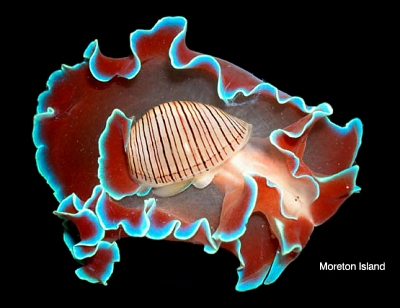
Concerning message #16645:
Hi Bill and Everyone!
Here is another record from our backyard. This is Hydatina physis which has been found subtidally and intertidally here. I have also taken taxonomic photos of the shell, showing the gills. Also it's food source, the polychaete worm, Cirratulidae, Timarete sp.
On dives the animal is found at night. Intertidally it occurs during the day time hours!
Locality: Sunshine Coast, sthn Queensland, 15 m - intertidal, Queensland, Australia, Pacific Ocean, 08 August 2008, Subtidal and Intertidal. Length: max 60 mm. Photographer: Gary Cobb.
Cheers
Gary
gary@nudibranch.com.au
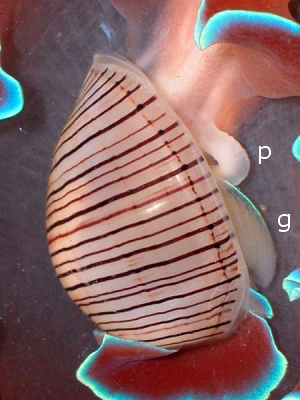
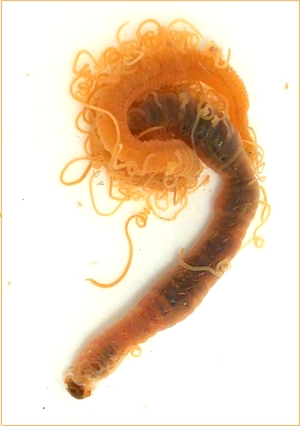
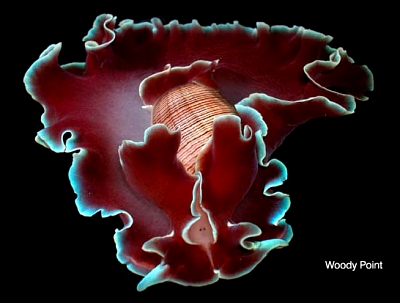
Dear Gary,
Thanks for these nice photos. In your photo of the shell we can see not only the gill [which I have marked g] but also the penis [p]. Hydatina is one of the few opisthobranchs which retains an external penis like this, almost all the others have an eversible penis which is usually hidden in an internal sac when not in use. In cephalaspideans this sac is usually on the right side of the head. Interestingly, many marine snails have an external penis situated in much the same position as Hydatina.
Thanks also for the photo of its food worm. Have you actually seen it feeding? Why I ask is that when I first discovered the food of this species I was relying on stomach contents. Because of the extremely elongated oral tube I suggested that it must capture its prey by everting this long 'proboscis' down the burrow of the worm, or the crevices in which it lives. Valda Fraser's photos [#21498] showing an everted black tube certainly supported this hypothesis, but I have never witnessed Hydatina actually feeding, so I would be interested in an 'eyewitness' account if you have seen it in action.
-
Rudman, W.B., 1972. The anatomy of the opisthobranch genus Hydatina and the functioning of the mantle cavity and alimentary canal. Zoological Journal of the Linnean Society, 51: 121-139.
Best wishes,
Bill Rudman
Hydatina physis from Florida
July 7, 2008
From: Linda Ianniello
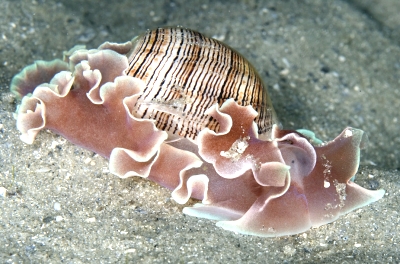
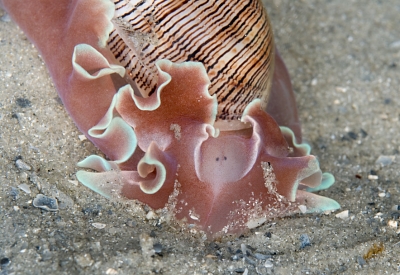
Concerning message #21498:
I couldn't resist sending you these shots of a Hydatina physis from the Atlantic! There are many shots of the Pacific ones, but very few of living animals from the Atlantic. I was thrilled to find it and get some shots .....
Locality: Lake Worth Lagoon, 5 feet, Florida, USA, Atlantic Ocean, 04 July 2008, Inlet, tidal. Length: approx 2 inches. Photographer: Linda Ianniello.
Thanks for the great forum and all the work you do on it.
Regards,
Linda I.
lindai1@bellsouth.net
Ianniello, L.M., 2008 (Jul 7) Hydatina physis from Florida. [Message in] Sea Slug Forum. Australian Museum, Sydney. Available from http://www.seaslugforum.net/find/21677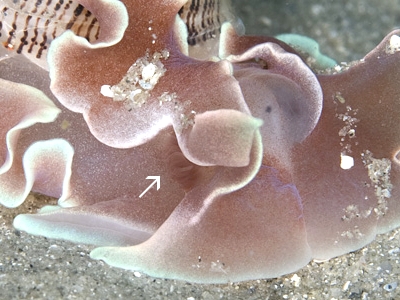
Dear Linda,
Thanks for an Atlantic example - of which we have very few. In fact I think yours is the first on the Forum from the west Atlantic. This Caribbean animal used to be considered a separate species, Hydatina vesicaria, but there appears to be no recognisable anatomical differences between it and the Pacific H. physis.
I have included a close-up alongside of the head as it shows part of the Hancocks Organ which is the chemosensory organ in primitive cephalaspidean sea slugs. Usually it is a pad or groove on each side of the head, but in species of Hydatina it consists of a row of folds or 'flaps'.
Best wishes,
Bill Rudman
Amazing proboscis on Hydatina physis from Sth Africa
April 8, 2008
From: Valda Fraser

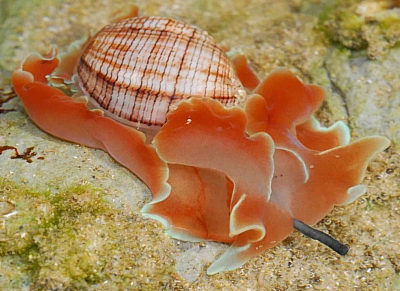
Dear Bill
I've often seen Hydatina physis, but never this proboscis. Amazing! What is it for?
Locality: Mpande, 15 cm, Eastern Cape, South Africa, Indian, 15 March 2008, intertidal pool. Length: 40 mm. Photographer: Valda Fraser.
Regards
Valda
valdafraser@mweb.co.za
Fraser, V.J., 2008 (Apr 8) Amazing proboscis on Hydatina physis from Sth Africa. [Message in] Sea Slug Forum. Australian Museum, Sydney. Available from http://www.seaslugforum.net/find/21498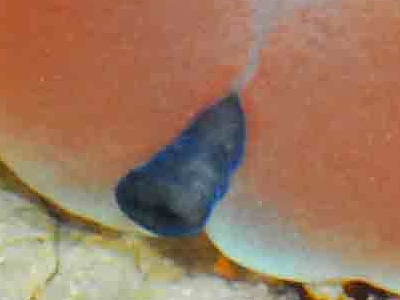
Dear Valda,
Thanks for these interesting photos. I have never seen Hydatina with its proboscis [= oral tube] extendedlike this but when I studied these animals 30 years ago I did find on dissection that they had a very long muscular oral tube. Some specimens also had remains of cirratulinid worms in their gut. Cirratulinid worms live in crevices or in sand burrows and feed by extending long sticky tentacles out over the nearby sand and rock to pick up detrital food particles. I suggested that during feeding, the long oral tube was extended out of the mouth so that the jaws and teeth on the end of it could be inserted into crevices and burrows to grasp these worms. There are large muscles attached to the oral tube which would then drag it back into the body. Your photos show that the oral tube does indeed extend some distance outside the mouth. I suspect it can extend at least twice as long again as in your upper photo.
Species of Micromelo, and some species of Bullina [B. lineata does, B. roseana doesn't] have a long oral tube like this. In 1972, I had no information on the feeding choice of Micromelo and Bullina but since then I have discovered cirratulinid worms, or parts of them, in the alimetary canal of both Micromelo undata and Bullina lineata.
- Rudman, W.B., 1972. The anatomy of the opisthobranch genus Hydatina and the functioning of the mantle cavity and alimentary canal. Zoological Journal of the Linnean Society, 51: 121-139.
- Rudman, W.B., 1972. Studies on the primitive opisthobranch genera Bullina Ferussac and Micromelo Pilsbry. Zoological Journal of the Linnean Society, 51: 105-119.
Best wishes,
Bill Rudman
Hydatina physis from Gold Coast, Queensland
May 20, 2006
From: Ian Banks
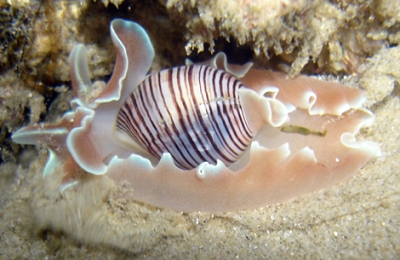
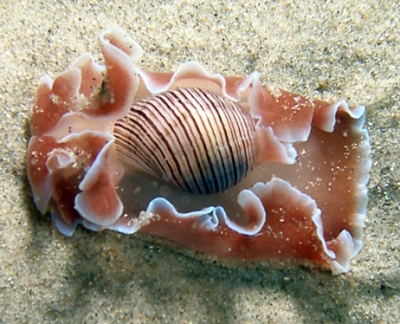
Bill,
These 3 Hydatina physis were photographed on the South Wall of the Gold Coast Seaway, all in the same area and depth, but on different dates.
Locality: South Wall, Gold Coast Seaway, 8 metres, Queensland, Australia, Pacific Ocean. Sandy bottom. Length: 4 cm. Upper Photo - 31 October 2005, 21 deg C; Middle Photo - 17 December 2005, 24 deg C; Lower Photo - 8 March 2005, 24 deg C. Photographer: Ian Banks.
rgds
Ian
ianbanks@bigpond.com
Banks I.W., 2006 (May 20) Hydatina physis from Gold Coast, Queensland. [Message in] Sea Slug Forum. Australian Museum, Sydney. Available from http://www.seaslugforum.net/find/16645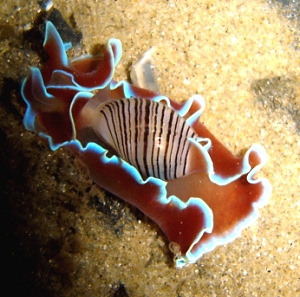
Dear Ian,
It's nice to get photos from the same locality showing the range in colour.
Best wishes,
Bill Rudman
Hydatina physis mating
July 2, 2005
From: Marina Poddubetskaia
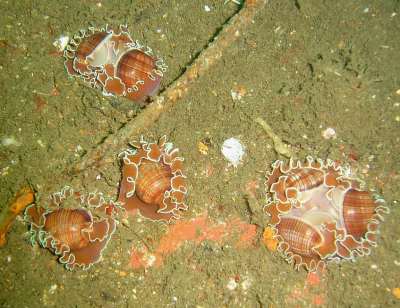
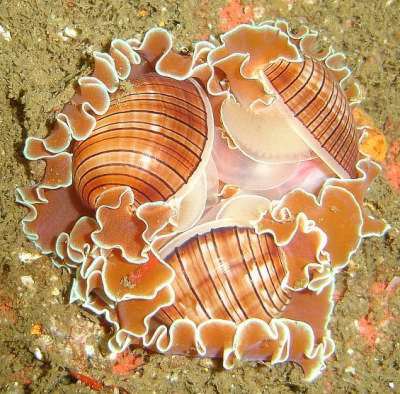
Dear Bill,
In Senegal I found a wreck full of Hydatina physis: they were everywhere on the deck, crawling, mating, laying eggs. I attach here 2 photos of mating animals. The one with 3 animals wanting to copulate all together is quite funny. I will send you the photos with eggs in a separate message [#14149 ].
Locality: 'Nimes' (wreck), Dakar, Senegal, Atlantic Ocean. Depth: 28 m. Length: 35-55 mm. 4-5 June 2005. Photos: Marina Poddubetskaia - Nembro website
Best wishes,
Marina.
nembro@nembro.info
Poddubetskaia, M., 2005 (Jul 2) Hydatina physis mating. [Message in] Sea Slug Forum. Australian Museum, Sydney. Available from http://www.seaslugforum.net/find/14148
Thanks Marina,
Hydatina physis seems to be another of those species which is often found in big aggregations. It is certainly nice to get some more photos of this Atlantic form of the species which Odhner gave the name H. stromfelti [see message #1835]. In your photo of the three animals together, you can see in the top right animal the cream coloured gill extending out from the mantle cavity within the shell. It penis, just below the gill, is probably impregnating the upper left animal. It seems the threesome is someone successful as it seems the top left animal is mating with the bottom animal. In the photo showing the two animals there is also an egg mass at the bottom right.
Best wishes,
Bill Rudman
Hydatina physis laying eggs
July 2, 2005
From: Marina Poddubetskaia
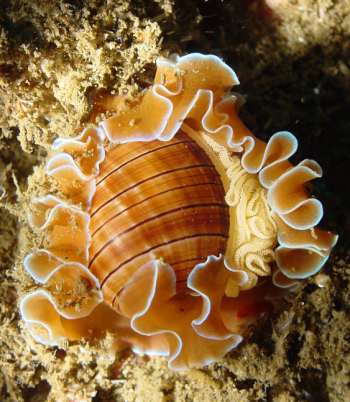
Dear Bill,
In addition to my previous message [#14148] here are the photos of Hydatina physis laying eggs and the related egg-ribbon.
Locality: 'Nimes' (wreck), Dakar, Senegal. Atlantic Ocean. Depth: 28 m. Length: animal: 55 mm. Egg ribbon: 27 mm. 4 June 2005. Photos: Marina Poddubetskaia - Nembro website
Best wishes,
Marina.
nembro@nembro.info
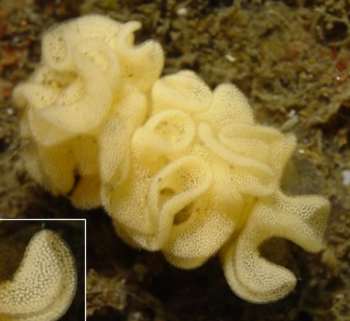
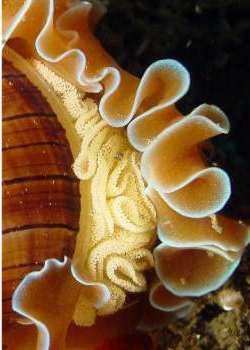
Thanks Marina,
Best wishes,
Bill Rudman
Mysterious pink nudibranch from New South Wales
January 27, 2005
From: Eliza Middleton
I was snorkelling today in about 1m of water at Fly Point in Nelsons Bay. On the rocky bottom amongst the seaweed I found a nudibranch I have never seen before. It had a small shell on it's back similar to that of a terrestrial snail (colouring), towards the end of the snail, that is not quite centered. It was then a pale pink in colour with a white outline. It was about 6 or 8cm long, it's skirt was large and I guess kind of flowy for want of a better word. It was one of the most beautiful nudi's I have ever seen. As luck would have it, no camera in sight, but if anyone could help me identify it I would be ever so grateful.
Thanks
Locality: Fly Point, Nelson Bay, Port Stephens, NSW, Australia
Depth: 1 metre. Length: 60 - 80 mm. 18 January 2005
rocky bottom with seaweed. Photographer: no photo (Damn!)
Eliza Middleton
scubadubadoo@hotmail.com
Dear Liza,
I can only guess without a photo, but your animal was probably Hydatina physis, which although a sea slug (opisthobranch) is not a nudibranch. Nudibranchs are a group of sea slugs in which the shell is completely lost except in the larval stages. Have a look at the Fact Sheet for Hydatina physis, and other attached messages, for further information.
Best wishes,
Bill Rudman
Hydatina physis laying eggs
January 28, 2004
From: Ian Hutton
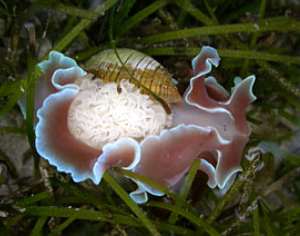
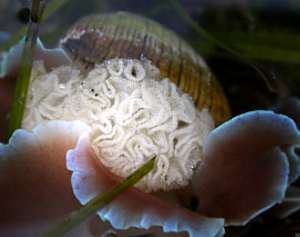
Hi Bill
It's warm water time at Lord Howe Island, and this afternoon [27 January 2004] I was wandering on seashore at low tide and came across 5 Hydatina physis on the lagoon sandy floor. One was either laying or carrying around eggs. I watched it for an hour on and off and it just crawled around with eggs on its mantle. I hope you like the pics.
Ian Hutton
lhitours@bigpond.com
Hutton, I., 2004 (Jan 28) Hydatina physis laying eggs. [Message in] Sea Slug Forum. Australian Museum, Sydney. Available from http://www.seaslugforum.net/find/12032Thanks Ian,
It's nice to get another observation of egg-laying behaviour in Hydatina. As I discussed in an earlier message from Japan, it seems that this species produces its whole egg mass before anchoring it in the substrate, which is rather different from most opistobranchs which cement the egg ribbon down as it is being layed. I found indications of the same procedure with Pupa kirki in New Zealand so perhaps it is a common behaviour within the Acteonoidea.
Best wishes
Bill Rudman
Hydatina physis from Japan
December 20, 2003
From: Yukari Sato
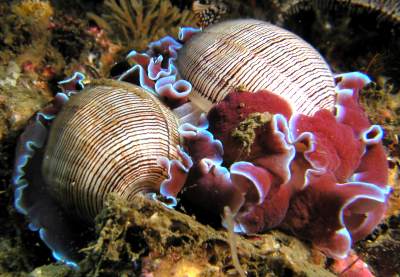
Hello Dr. Rudman,
Here are images of an egg-laying and mating in Hydatina physis.
Date: 11 Nov 2003
Depth: 14m
Length: approx.40mm
Location: Zushi (near Hayama), Sagami Bay, Japan
Best regards,
Yukari Sato
yukarisss@hotmail.com
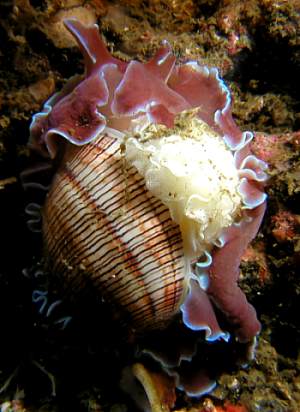
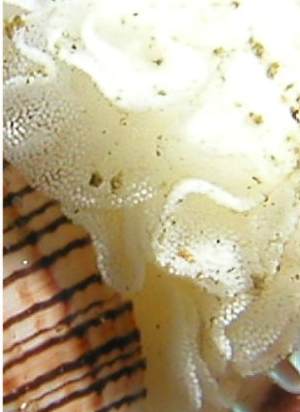

Thanks Yukari,
Hydatina and the related animals in the superfamily Acteonoidea are considered very primitive opisthobranchs. Apart from obvious primitive signs such as having an external shell, these animals all have a large external penis. In all other opisthobranchs the penis is internal and only everts during mating.
From your photos, and others I have seen, the egg ribbon of Hydatina also interesting in the way it is formed. It seems as though the whole ribbon is completely produced before it is attached to the substrate. The egg ribbon of Hydatina is attached by a mucus thread or string which is anchored in the sediment. It seems that anchoring the ribbon is the last stage in the process and only occurs after all the ribbon is exuded from the genital opening. A quite different process than that of nudibranchs and other opisthobranchs which gradually attach the ribbon as it is being exuded from the genital pore.
Best wishges
Bill Rudman
Re: A rose of a different color
October 6, 2003
From: Paul Whitehead
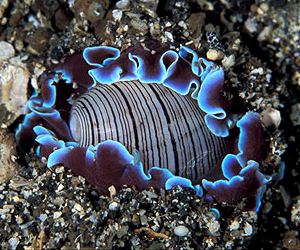
Dear Dr. Rudman,
Similar to Mary Jane's example from Papua New Guinea this Hydatina physis taken at Nudi Falls, Lembeh Straits (Sulawesi, Indonesia) on September 14, 2003 on a sandy bottom around 8 meters had an almost iridescent mantle edge with the rest being very dark compared to other examples. Total length was approx 5cm.
Paul
Whitehead@damnam.org
Whitehead, P., 2003 (Oct 6) Re: A rose of a different color. [Message in] Sea Slug Forum. Australian Museum, Sydney. Available from http://www.seaslugforum.net/find/11146Thanks Paul,
This species is quite variable in its colour shading. It can range from this very dark form to a pale pinkish white in which the bluish border is almost invisible.
Best wishes
Bill Rudman
Hydatina physis from Japan
June 11, 2003
From: Kayoko Eto
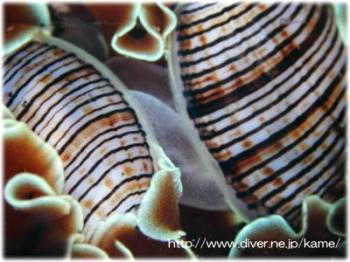
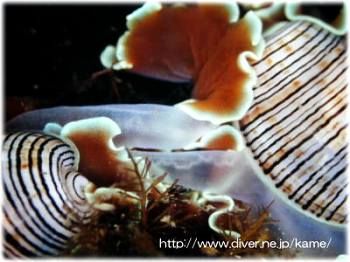
Dear Bill,
I found these Hydatina physis copulating at Osezaki beach in Japan. I observed then until they finished.
Could you tell me what the object in the third [lower] photo is please?
Data:
Date: 4 June,2003
Location: Osezaki beach, Suruga Bay, Pacific coast of Japan
Depth: 2m
Length: 10cm×2
W/temp: 20 C degree
Photo by Kayoko Eto
Best Regards,
Kayoko Eto
kame@diving.to
Eto, K., 2003 (Jun 11) Hydatina physis from Japan. [Message in] Sea Slug Forum. Australian Museum, Sydney. Available from http://www.seaslugforum.net/find/10187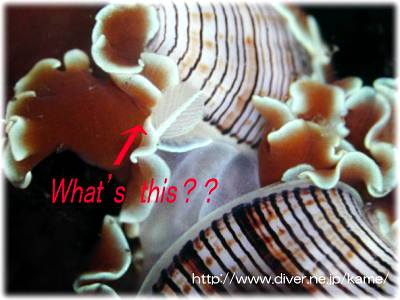
Dear Kayoko,
I don't think the feathery object is part of the Hydatina. Could it possibly be a fish scale or something similar that has got stuck on the edge of the foot? I have dissected a few of these animals over the years and I can't recall any organ that looks like this, so I can only guess that it's something from the sand that has got stuck on the foot.
Best wishes,
Bill Rudman
Pair of Hydatina physis
June 7, 2003
From: Leanne & David Atkinson

Dear Bill,
After reading about the N.Z. Philinopsis taronga mating, we wondered whether this pair of Rose Petal Bubble shells [Hydatina physis] we found may have been mating. Summer 2003 was a good year for Hydatina physis.
Location: Fly Point, Port Stephens, NSW, Australia. January 2003. Depth: 5m
Thanks for your help,
Leanne & David Atkinson
atk@hunterlink.net.au
Atkinson, L. & D., 2003 (Jun 7) Pair of Hydatina physis. [Message in] Sea Slug Forum. Australian Museum, Sydney. Available from http://www.seaslugforum.net/find/10147Dear Leanne & David,
Its possible they are mating but it could be that they have caught the scent of the cirratulid worms they eat.
Best wishes,
Bill Rudman
Hydatina physis from Senegal
April 19, 2003
From: Marina & Patrice
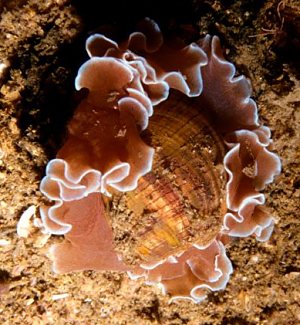
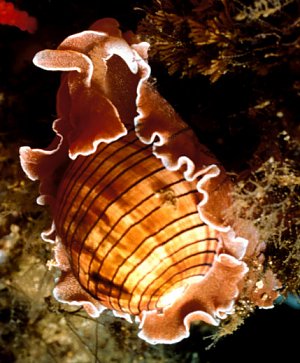
Dear Bill,
Here are two specimens of Hydatina physis from Dakar, Senegal.
These photos were taken by Patrice in April 1999.
Upper Photo: Tacoma Wreck, Depth: 10m
Lower Photo: Thiouriba, Depth: 28m
Best wishes,
Marina Poddubetskaia
nembro@nembro.info
Patrice Petit de Voize
PdeVoize@aol.com
Poddubetskaia, M. & Petit de Voize, P., 2003 (Apr 19) Hydatina physis from Senegal. [Message in] Sea Slug Forum. Australian Museum, Sydney. Available from http://www.seaslugforum.net/find/9682Dear Marina & Patrice,
It's nice to see living animals of this East Atlantic form of Hydatina physis. This is the form that Odhner (1931) desribed from the Canary Ids as Hydatina stromfelti. In an earlier message I discuss my anatomical studies of this form, but I only had preserved animals to look at.
Best wishes,
Bill Rudman
Hydatina physis from Lord Howe Island
January 24, 2003
From: W.B. Rudman
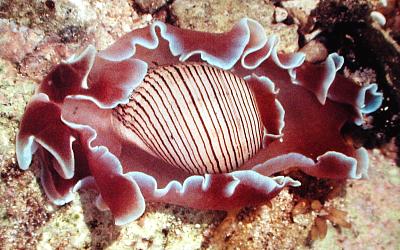
Here is a photo record from Ian Hutton of Hydatina physis from Lord Howe Island.
Location: Middle Beach.
Bill Rudman
Rudman, W.B., 2003 (Jan 24) Hydatina physis from Lord Howe Island. [Message in] Sea Slug Forum. Australian Museum, Sydney. Available from http://www.seaslugforum.net/find/8967Hydatina physis - more photos
June 2, 2001
From: George Evatt
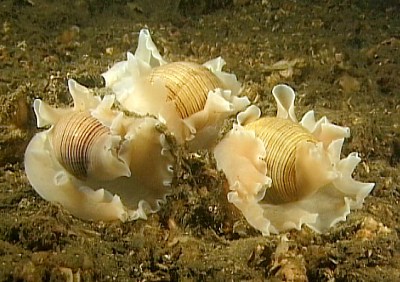
Hi Bill,
Here are some more photos of the animals from Clifton Gardens. They are actually stills from my digital U/W video camera. The biggest group I found on the second night were 3 together, thought there were dozens of them about.
Regards
George
coralsea@intercoast.com.au
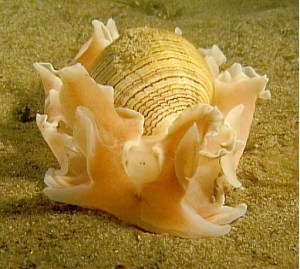
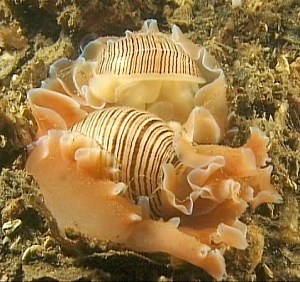
Thanks George,
I have only ever found them once in large numbers but I regularly am told of people seeing large aggregations of them together. I guess like Aplysia aggregations its just a case of a simultaneous settlement of lots of larvae together all reaching maturity about the same time. The problem with trying to study something like this is that there is no way to be sure just where and where it will happen again.
One intersting feature you can see in your photos is how the colour of the animal can vary considerably depending on the lighting. It is not just an artefact photography and can appear this way when viewed with the naked eye.
Best wishes,
Bill Rudman
Hydatina physis in Sydney
June 1, 2001
From: George Evatt
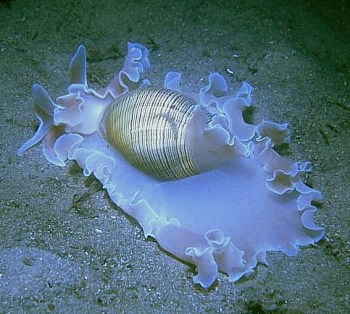
Hi Bill,
I was diving at Clifton Gardens in Sydney Harbour [NSW, Australia] last night [21 May 2001] and I came across a dozen of these Hydatina physis. I see these shells around quite a bit but not with the mantle out.
Thanks
George Evatt
coralsea@intercoast.com.au
Evatt, G., 2001 (Jun 1) Hydatina physis in Sydney. [Message in] Sea Slug Forum. Australian Museum, Sydney. Available from http://www.seaslugforum.net/find/4439Thanks George,
Yes these are quite spectacular animals. If you have some photos of them clustering together, mating etc I would be interested in seeing them.
Best wishes,
Bill Rudman
A rose of a different color
June 6, 2000
From: Mary Jane Adams
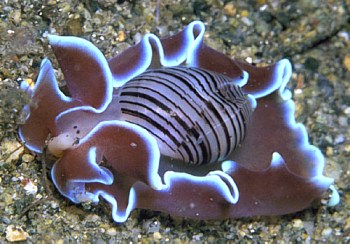
Dear Bill,
Here is different color of Hydatina physis for your files. I found it on a dusk dive near Esa'ala wharf at the northern end of Normanby Island, Papua New Guinea. The blue border on the mantle appeared almost flourescent.
Length of shell = 15mm, total length of the animal was 30 mm. Depth 5 mm. May 23, 2000
Best Regards,
Mary Jane
mjadams@earthlink.net
Adams, M.J., 2000 (Jun 6) A rose of a different color. [Message in] Sea Slug Forum. Australian Museum, Sydney. Available from http://www.seaslugforum.net/find/2510Dear Mary Jane,
The common name, at least in Australia, of Hydatina physis - The Rose-petal Bubble Shell - is one of the few common names for opisthobranchs which does justice to the animal. It has an amazing variability in colour from almost translucent white to this deeper reddish ink. Both it and
Bullina lineata can have the brilliant flourescent blue border which is so difficult to capture on film.
Best wishes,
Bill Rudman.
Hydatina, again
February 15, 2000
From: Peter Wirtz
Dear Bill,
I am currently reviewing the (German translations of the) book by G. Gabbi "Shells- Guide to the Jewels of the Sea" (1999). It contains two
puzzling statements about Hydatina.
1) It claims that H. physis can swim, because it has a very light shell. ???
2) It claims that the species Hydatina hydatis has a foot "transformed into a swimming organ" and that it leads an entirely pelagic life.??
I do not know the latter species. Its foot does not look much different from that of H. physis, which appears to me much too bulky a creature to swim.
Any comments ?
Cheers,
Peter.
peter.wirtz@clix.pt
Wirtz, P., 2000 (Feb 15) Hydatina, again. [Message in] Sea Slug Forum. Australian Museum, Sydney. Available from http://www.seaslugforum.net/find/1905Dear Peter,
Your quotations remind me of those medieval bestiarys where weird animals were described and even weirder tales told about them.
I certainly know of no record of any species of Hydatina swimming. The H. hydatis she mentions is probably the European Haminoea hydatis, but I am sure it does not swim either.
The most likely candidate would be the aplysiid Akera bullata Muller, 1776. which has a Haminoea-like shell and is a well-known, if clumsy swimmer.
Best wishes,
Bill Rudman.
Hydatina stromfelti v Hydatina physis
February 2, 2000
From: Marco Neiber
Dear Dr. Rudman,
I read your internet pages about the genus Hydatina! I have five Hydatina specimens from the Canary Islands in my collection which Odhner, 1931 describes as a new species (Hydatina stromfelti). The living animal resembles the one of Hydatina physis, but the shell features are
different in many ways. I would like to know if Hydatina stromfelti Odhner, 1931 is a valid species, a subspecies of Hydatina physis or a geographical variant of Hydatina physis.
I hope to hear from you.
Yours,
Marco Neiber,
Germany.
Marco_Neiber@hotmail.com
Neiber, M., 2000 (Feb 2) Hydatina stromfelti v Hydatina physis. [Message in] Sea Slug Forum. Australian Museum, Sydney. Available from http://www.seaslugforum.net/find/1835Dear Marco,
Many years ago I looked at the shells and animals of animals of H. stromfelti from the Canary Islands, H. vesicaria from Atlantic and H. physis from parts of the Pacific and concluded that they were all one species. I could find no anatomical differences and no consistent shell differences. I have recently looked at a range of shells in the Australian Museum collections and can find more variation within shells from one part of the Indo-West Pacific (eastern Australia) than I can between oceans. My feeling therefore remains that there is one circumtropical species, much like we now consider there is one circumtropical species of the related Micromelo.
Reference:
• Rudman, W.B., 1972. The anatomy of the opisthobranch genus Hydatina and the functioning of the mantle cavity and alimentary canal. Zoological Journal of the Linnean Society, 51: 121-139.
Best wishes,
Bill Rudman.
Food for the bubble shell Hydatina physis?
December 19, 1999
From: Ian Smith
An enquirer found a live Hydatina physis = Rose petal bubble shell, and wishes to feed it.
Sea Slug Forum states the genus specialises in cirratulinid polychaete worms as food. Has he a chance of providing these, or would say baitworms (Marphysa) or something else readily available do the job.
Ian Smith
NSW Fisheries
smithi@fisheries.nsw.gov.au
Smith, I., 1999 (Dec 19) Food for the bubble shell Hydatina physis?. [Message in] Sea Slug Forum. Australian Museum, Sydney. Available from http://www.seaslugforum.net/find/1690Dear Ian,
Years ago I looked at the stomach contents of H. physis from various localities around the world, as well as other related species, and in all cases the worm remains were easily identified as belonging to the Cirratulinae, a subfamily of the Cirratulinidae. Over the years I have checked the odd stomach and again have only found similar worms, suggesting they are fairly specific feeders.
However as Marphysa would be a lot easier to collect, I guess anything is worth a go. I remember keeping a new Zealand species of worm-eating aglajid, Melanochlamys cylindrica, alive in aquaria for many months on worms that it could not possibly feed on in nature. Species of Melanochlamys feed by rapidly sucking in polychaete worms much like sucking in a long piece of spaghetti. I often found them stuck head down in coralline algae turf, one end of a eunicid or nereid worm in their mouth and the other end desperately trying to escape into a crack or burrow. Collecting nereid worms for them to eat was a time consuming task so on one occasion I decided to test them on Sabellaria kaiparaensis, a worm which builds a tube from sandgrains and clusters in large colonies forming sandy reefs on the shore. Large numbers of worms could be quickly extracted by breaking off sections of the reefs. I would then freeze them in conveniently sized 'ice-blocks' and throw a block into the aquarium every few days where it would melt. The worms would thaw out and the aglajids would eat them with great enthusiasm. It seems in that case the aglajids were eating certain worms on the shore, not so much from choice, but because they were able to catch them.
It is possible with Hydatina that it eats cirratulid worms because they are relatively easy to catch in the areas in which it lives. If so then perhaps it would eat other types of worms if they were offered. To have any chance of success though, I suspect they would have to be freshly dead, as alive they would probably move to fast for Hydatina.
For those with no idea about polychaete worms, cirratulids have no head appendages but have long thread-like tentacles along most of the body but especially around the head. They live in crevices, empty burrows or under rocks partially embedded in the sand or mud. They live surrounded by a 'coccoon' of debris, and they extend their tentacles out like the head tentacles of terebellid worms, to collect food particles. On the other hand, eunicid worms like Marphysa, although living in burrows, are quite active worms emerging either partially or fully from their burrow to feed on carrion, or in some cases, algae.
Ian, if your enquirer has any success with Marphysa, I would be interested to hear about it. Collecting cirratulinid worms would probably be quite difficult and require quite extensive environmental disturbance, turning embedded rocks and digging and scraping around to find them.
Best wishes,
Bill Rudman.
What is the 'Rose Petal Bubble Shell'?
August 23, 1999
From: Lauren Peck
Dear Dr Rudman,
I am doing an assignment on Opisthobranchs and have come across a species which I would like to include in it. However, the only information that I have is the common name of it: the Rose Petal Bubble Shell. If you have any information on this species could you send it to me asap? That would be really, really helpful,
Thank you very much,
Lauren Peck.
lpec5603@pop.usyd.edu.au
Dear Laureen,
Common names are a real problem. Usually only the author who invented them uses them and so they are hardly 'common'. It would be better if publishers treated their readers with some intelligence and stopped insisting on authors making up common names.
The animal with this name is Hydatina physis, which you'll see from the photo has a proportionally large frilly body which could be likened to rose petals. The cephalaspid Bubble Shells are an interesting group of Sea Slugs with modern representatives showing all the evolutionary stages the ancestors of today's Sea Slugs must have gone through to become shell-less slugs. Have a look at Pupa and Bullina to see two more snail-like representatives. Also have a look at the pages on Detorsion - how snails became slugs, What is a slug?, and torsion and nudibranch gills for general information on the topic.
Best wishes,
Bill Rudman.
